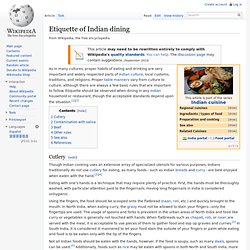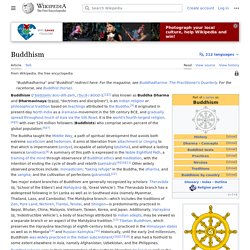

Regions. History Of India. Geography of India. This video was taken by the crew of Expedition 29 on board the ISS on a pass from western Europe to Central India.

India. Encyclopedia Britannica. Culture of India. Etiquette of Indian dining. As in many cultures, proper habits of eating and drinking are very important and widely respected parts of Indian culture, local customs, traditions, and religions.

Proper table manners vary from culture to culture, although there are always a few basic rules that are important to follow. Etiquette should be observed when dining in any Indian household or restaurant, though the acceptable standards depend upon the situation.[1][2] Cutlery[edit] Though Indian cooking uses an extensive array of specialized utensils for various purposes, Indians traditionally do not use cutlery for eating, as many foods - such as Indian breads and curry - are best enjoyed when eaten with the hand.[3][4] Eating with one's hands is a technique that may require plenty of practice. Kila Raipur Sports Festival. Competition is held for major Punjabi rural sports, include cart-race, rope pulling.

In February each year, Ludhiana becomes the destination for hundreds of sports enthusiasts, including foreigners. They come to Kila Raipur to see the special breed of bullocks, camels, dogs, mules and other animals competing in competitive events. The most prestigious winners have attended. Indian Fairs and Festivals. Indian religions. Ganesha, a deity common to Hindus, Jains, and Buddhists.

Primarily a widely-worshipped Hindu deity. Indian religions are the religions that originated in the Indian subcontinent; namely Hinduism, Jainism, Buddhism and Sikhism. [web 1][note 1] These religions are also classified as Eastern religions. Buddhism. Religion founded by the Buddha Buddhism (, ) is an Indian religion based on a series of original teachings attributed to Gautama Buddha.

It originated in ancient India as a Sramana tradition sometime between the 6th and 4th centuries BCE, spreading through much of Asia. It is the world's fourth-largest religion[3] with over 520 million followers, or over 7% of the global population, known as Buddhists.[6] Buddhism encompasses a variety of traditions, beliefs and spiritual practices largely based on the Buddha's teachings (born Siddhārtha Gautama in the 5th or 4th century BCE) and resulting interpreted philosophies. Two major extant branches of Buddhism are generally recognized by scholars: Theravāda (Pali: "The School of the Elders") and Mahāyāna (Sanskrit: "The Great Vehicle"). Theravada has a widespread following in Sri Lanka and Southeast Asia such as Cambodia, Laos, Myanmar and Thailand.
Sikhism. Sikhism, known in Punjabi as Sikhi,[note 1] (/ˈsiːkɨzəm/ or /ˈsɪkɨzəm/; Punjabi: ਸਿੱਖੀ, sikkhī, IPA: [ˈsɪkːʰiː]) is a monotheistic religion founded during the 15th century in the Punjab region of the Indian subcontinent, by Guru Nanak[3] and continued to progress through the ten successive Sikh gurus (the eleventh and last guru being the holy scripture Guru Granth Sahib.

The Guru Granth Sahib is a collection of the Sikh Gurus' writings that was compiled by the 5th Sikh Guru). It is the fifth-largest organized religion in the world, with approximately 30 million adherents.[4][5] Punjab, India is the only state in the world with a majority Sikh population. Adherents of Sikhism are known as Sikhs (students or disciples). According to Devinder Singh Chahal, "The word 'Sikhi' (commonly known as Gurmat) gave rise to the modern anglicized word 'Sikhism' for the modern world. SinghSahib.com : Sikh Gurus, Sikhism, Sikhs, Nitnem, Shabad Kirtan, Sukhmani Sahib, Sikh History, Picture Gallery, Sikh Baby Names.
Welcome to website about history of the sikhs. Hinduism. Hinduism is the dominant religion, or way of life,[note 1] in South Asia, most notably India.

It includes Shaivism, Vaishnavism and Shaktism among numerous other traditions, and a wide spectrum of laws and prescriptions of "daily morality" based on karma, dharma, and societal norms. Hinduism is a categorisation of distinct intellectual or philosophical points of view, rather than a rigid, common set of beliefs. Hinduism, with about one billion followers[web 1] is the world's third largest religion, after Christianity and Islam. Hinduism has been called the "oldest religion" in the world,[note 2] and some practitioners refer to it as Sanātana Dharma, "the eternal law" or the "eternal way"[3] beyond human origins.
Western scholars regard Hinduism as a fusion[note 3] or synthesis[note 4] of various Indian cultures and traditions,[6][note 5] with diverse roots[note 6] and no single founder. Etymology Definitions Colonial influences Indigenous understanding Sanātana Dharma Growing Hindu identity. History of Ancient India. Early Historic Period Vedic Period: The Aryans were the first to invade the country.

They came out of the North in about 1500 BC and brought with them strong cultural traditions. Jainism. Jainism (/ˈdʒeɪnɪzəm/[1] or /ˈdʒaɪnɪzəm/[2]), traditionally known as Jin Sashana or Jain dharma (Sanskrit: जैन धर्म), is an Indian religion that prescribes a path of nonviolence (ahimsa) towards all living beings.

Practitioners believe that nonviolence and self-control are the means by which they can obtain liberation. The three main principles of Jainism are non-violence (ahimsa), non-absolutism (anekantavada) and non-possessiveness (aparigraha). Followers of Jainism take 5 major vows: non-violence, non-lying, non-stealing, chastity, and non-attachment. Asceticism is thus a major focus of the Jain faith. Jainism is derived from the word Jina (conqueror) referring to a human being who has conquered inner enemies like attachment, desire, anger, pride, greed, etc. and possesses infinite knowledge (Kevala Jnana). Doctrine[edit] Non-violence (ahimsa)[edit] The hand with a wheel on the palm symbolizes Ahimsa (nonviolence).